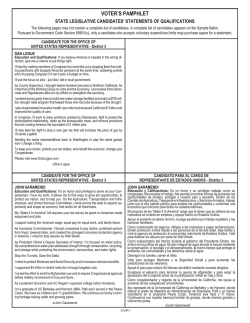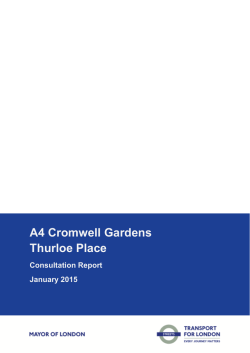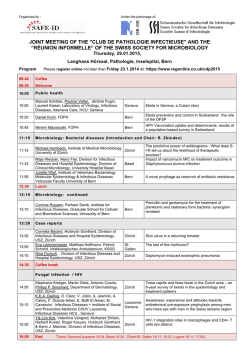
Cómo devolver a los peatones su soberanía en las zonas - Walk21
Cómo devolver a los peatones su soberanía en las zonas urbanas: El ejemplo de la ciudad de Ginebra. Upgrading pedestrians in an urban setting. The example of the City of Geneva. Marie-José Wiedmer-Dozio Head of the Town Planning Department of the City of Geneva, 4 rue de Jargonnant – 1207 Geneva (Switzerland) Tel ++41(0)22-418.60.44 E-mail : [email protected] Resumen / Abstract El Plan Peatonal de la Ciudad de Ginebra se ajusta a una política que fomenta el desarrollo sostenible. Desde hace varios años, las autoridades han emprendido la restauración de la libertad de la ciudad para los peatones, un compromiso basado en los siguientes principios generales: § Mejora gradual de la denominado “mobilité douce” en las ciudades (es decir, un tipo de movilidad más amiga del usuario); § Mejora de la calidad del aire y reducción de los efectos nocivos del tráfico motorizado; § Garantía de la seguridad, el atractivo, la animación y la jovialidad en las calles; § Mejora de la calidad y la salubridad de vida en beneficio de los ciudadanos. El objetivo de la primera fase del Plan Peatonal, iniciado en 1995, era mejorar los espacios urbanos ya existentes. En la actualidad, la Ciudad está llevando a cabo la segunda fase de su política, poniendo en práctica un plan de desarrollo de rutas para peatones que abarca todo el territorio. Este programa de medidas de gran alcance programado para los próximos diez años, se halla ahora inscrito en un decreto del parlamento. Por tanto, descansa sobre una base financiera y legal firme, y se beneficia del reconocimiento político tanto a nivel comunal como cantonal. Las numerosas medidas concretas elaboradas en esta segunda fase – que fomentan activamente a los usuarios la adopción de una actitud diferente – están guiadas por los siguientes cinco objetivos: § Fomento de la movilidad a pie: con la creación de “paseos temáticos”; § Mejora de plazas y áreas específicas en todos los barrios: planificación y desarrollo de espacios públicos con especial relevancia, por ejemplo, la Plaza de las naciones Unidas, así como áreas para uso cotidiano; Cómo devolver a los peatones su soberanía en las zonas urbanas: ejemplo de la ciudad de Ginebra Upgrading pedestrians in an urban setting. The example of the City of Geneva Marie-José Wiedmer-Dozio § Promoción de la movilidad a pie: nueva planificación de cruces, zonas escolares, entradas a parques, áreas comerciales, etc.; § Eliminación de obstáculos en las rutas peatonales: refuerzo y desarrollo de la red peatonal en todo el territorio (cesión de la propiedad de la tierra, derechos de paso); § Regulación del tráfico en los barrios: equilibrio adecuado entre las medidas normativas y el desarrollo de cruces peatonales. Desde el inicio, una de las prioridades de la política del Plan Peatonal fue garantizar que todas las personas implicadas fueran totalmente conscientes de cada medida y de las razones para la misma. Se organizan campañas de promoción e información, así como estrategias de márketing de la planificación urbana, de forma regular y coherente durante todo tipo de eventos públicos. Más aún, se otorga un especial cuidado al lenguaje utilizado, al diseño gráfico, así como a los diversos tipos de actividades de las campañas y su sincronización. La Ciudad de Ginebra ha elaborado numerosas y variadas operaciones: algunas son espectaculares – por ejemplo, el proyecto "Fil du Rhône" (A lo largo del río Rhône), los seis “paseos temáticos”, la replanificación de los cruces importantes, los programas diseñados específicamente para las escuelas. Otras son más discretas – por ejemplo, el desarrollo de unos cien cruces peatonales seguros en las vías públicas principales durante los últimos dos años. Tanto los habitantes como los visitantes de la ciudad se benefician del Plan Peatonal, que ha recibido dos distinciones nacionales en el año 2001: el premio a la Innovación otorgado por la Asociación Suiza de transporte, medio ambiente y movilidad peatonal (ATE –VTE) y el premio a la Seguridad concedido por el Fondo de Seguridad Suizo. Pero, finalmente, el aspecto más satisfactorio del programa es una nueva concienciación sobre la idea de la movilidad a pie fomentada en la Ciudad de Ginebra. Más especialmente, los ingenieros, los arquitectos y los planificadores urbanos tienen ahora en cuenta este aspecto de forma específica. Integran, deliberadamente, áreas que promocionan las actividades sociales y garantizan la movilidad a pie para todo tipo de usuarios y en todos los niveles. Más información en francés e inglés en la página web: www.ville-ge.ch/plan-pietons Ponencia / Paper Since 1995, the City of Geneva has not only developed a planning mechanism for coordinating legal, technical, administrative and financial aspects but has above all managed to instil in all users of the public space a new pro-pedestrian state of mind, based on the following principles: § Restore a "positive" image of the pedestrian in an urban setting, for "we are all pedestrians"; § Anticipate safety hazards for pedestrians in the public space even before accidents occur; § Work out comprehensive measures for the entire territory to be implemented over the next decade and beyond; § Instead of making empty promises to citizens, give priority to sustainability and consistency as far as improvements to the public space are concerned, taking pains to ensure that such improvements are practical, high-priority and easily understandable; § Develop original solutions that are temporary (intersection of Bd Saint-Georges and rue des Bains) or even short-lived (e.g. Place Saint-François) to test ideas, gain experience and reassure sceptics; § Rely on a transparent, learning-oriented approach as far as the public is concerned, by ensuring that it shares in both successes and difficulties, by using easily understandable language and by making certain measures appealing or even fun (e.g. walks); 2 Cómo devolver a los peatones su soberanía en las zonas urbanas: ejemplo de la ciudad de Ginebra Upgrading pedestrians in an urban setting. The example of the City of Geneva Marie-José Wiedmer-Dozio § Create awareness among citizens, in associations, financial circles, etc. with a view to actively ensuring that sustainable development is taken into consideration. A five-stage master plan The master plan for pedestrians, which covers the entire territory, comprises the following five stages: Encouraging walking (stage 1) Walking is an activity that is appreciated by a large share of the population. Not only is it excellent for health and meaningful in terms of culture and identity, it is a unique means of discovering and taking in a territory. With its varied landscape, where heavily built-up areas adjoin parks or even completely undeveloped areas, Geneva offers many potential walks that are still underused, unfamiliar or forgotten. The relevant lines of action are: § Specially designed walks Walks are laid out in connection with urbanisation projects, existing routes are revamped and the park network is supplemented whenever the opportunity arises. § Promotion A set of booklets featuring possible walks has been published since 1995. They have become more and more popular over time (40,000 copies per walk distributed every year). There will be seven of the illustrated guide-maps by June 2002. They are fun, practical, well-researched and published in English and French, and lead many inhabitants, visitors and tourists to discover the City of Geneva, its town planning, its monuments, its green spaces, its history, etc. Several walks spill over onto neighbouring communes. Plans call for building up a set of ten walks, each featuring a different theme: changes in the estates of patrician families, historic sites and museums, the development of means of transport, the presence of water in all its forms, the alliance between technology and water, the transition between work and leisure, health and town planning. Enhancing specific areas and squares in every neighbourhood (stage 2) In a world where the neighbourhood grocer's shop has been replaced by the petrol station/grocer's, where the post office, the bank, the cinema…. are tending to move out of the city into "drive-ins" or suburban "malls" mainly accessible by car, the amount of places where pedestrians can meet in town has dwindled away to almost nothing. This trend has generated new needs, which shape the social lives of the population - particularly the elderly who have trouble getting about – as well as the way in which the inhabitants make the city theirs, democratically speaking. The relevant lines of action are: § Downtown The project to extend the pedestrian zone at the foot of the old town and the city centre on the right bank must become a reality. As for shopkeepers' fears, a recent study1 showed that no major changes with regard to the availability of shops are to be expected in the downtown area and that extending the pedestrian zone offers shopkeepers in downtown Geneva a real opportunity. It is a tool for promoting downtown areas and enhancing their ability to compete with the large suburban shopping malls, which is something visitors are looking for when it comes to the quality of urban life. § Squares Projects involving emblematic and already overloaded squares are most certainly complex (Place des Nations in front of the United Nations Office in Geneva). In every case, the City reasserts the rights of pedestrians: redevelopment of existing squares and creation of squares in new neighbourhoods. § Other pedestrian areas 3 Cómo devolver a los peatones su soberanía en las zonas urbanas: ejemplo de la ciudad de Ginebra Upgrading pedestrians in an urban setting. The example of the City of Geneva Marie-José Wiedmer-Dozio Meeting on a daily basis does not require large areas. On the contrary, the best solution is interconnecting small, well-designed areas. Shopping streets should be made more convenient for pedestrians. Many "broken-down sites" currently used for other purposes (car parks, depots, building sites, etc.) represent a pool of potential public areas and should be restored to pedestrians. Promoting pedestrian mobility (stage 3) The sheer inconvenience of crossing many Geneva intersections on foot (push-buttons, long waits, traffic lights with free right turns for cars, unsynchronised lights, etc.) leads many pedestrians to take risks2. Likewise, many narrow, crowded pavements are dangerous and awkward. Moreover, children and the elderly are the most vulnerable users3. Such conditions devalue the status of pedestrians, causing them to prefer travelling by car. The relevant lines of action are: § Intersections Pedestrians must be given higher priority when it comes to the sequence of traffic lights at intersections, generally geared to the smooth flow of automobile traffic. Solutions have already been introduced (intersection of Sainte-Clotilde and Carl-Vogt). New standards must be developed, tested and applied (timing, synchronisation, diagonals, etc.). § Schools Safety arrangements for school surroundings (e.g. school kit) must be rounded out by the development of safe routes – the only credible alternative making it unnecessary to drive children to and from school for safety's sake4. § Old people's homes The elderly, who often suffer from impaired mobility and vision, must enjoy optimum safety conditions near their place of residence, on the way to nearby stores and facilities and at the nearest bus stop5. § Park entrances Park entrances, which are also places where pedestrians tend to congregate, must also be upgraded, often via enlargement, so as to ensure safety, conviviality and comfort. § Shopping streets Pedestrians should be able to cross shopping streets at several places thanks to pedestrian crossings and overall reductions in speed limits6. Such streets should feature corners where pedestrians can stop, benches where they can rest their legs, put their shopping down, phone, chat and watch the action in absolute safety. Eliminating obstacles on pedestrian routes (stage 4) Since they move relatively slowly, pedestrians like through streets, short-cuts, cut-throughs, etc. and hate dead-ends, which force them to turn back. The numerous city centre streets, with tightly packed islands and semi-public courtyards, are made for pedestrians, unlike urban suburbs, where their few streets and fenced-off plots are hostile, almost invariably resulting in the use of motorised transport. Several types of obstacles must be eliminated: functional breaks (railway tracks), geographical breaks (rivers, cliffs), land-related breaks (private, fencedoff plots) or breaks linked to the clutter of the public space (telephone poles, illegally parked cars). The relevant lines of action are: § Strengthening the downtown area and developing a pedestrian network in the suburbs This step can be implemented in one of two ways: either by considering that each town planning project offers an opportunity or by improving the situation on a case-by-case basis, giving priority to amicable settlements or – following the breakdown of negotiations and in case of absolute need – through the procedure of the localised 4 Cómo devolver a los peatones su soberanía en las zonas urbanas: ejemplo de la ciudad de Ginebra Upgrading pedestrians in an urban setting. The example of the City of Geneva Marie-José Wiedmer-Dozio § pedestrian route plan (PLCP), accompanied by a public notice paving the way for expropriation. Improving the management of existing public spaces This measure implies in particular forcing other users (motorists, scooter riders, cyclists, shopkeepers, etc.) to respect the area set aside for pedestrians and ensuring that proper road signs, signals and equipment are installed all along the way. Slowing traffic down at the neighbourhood level (stage 5) Although various traffic moderation measures have been tested and applied in the City of Geneva, they have always been limited to a very restricted area. To be truly effective, they must be redesigned for application on a coherent scale, which could become a reference for all users of the public space. Today, motorists who move from one traffic zone to another without understanding the reason for the change tend to ignore such restrictions! Traffic must be slowed down in neighbourhoods delimited by high-density routes belonging to the main network. As soon as motorists leave the main network, they realise that they are entering a neighbourhood with lower speed limits, change their driving habits accordingly and gradually incorporate this reflex into their town driving habits. The relevant lines of action are: § In the neighbourhoods The entire range of traffic regulation measures (30 km zones, residential streets, meeting areas, one-way streets, dead-ends, etc.) is to be used, depending on the neighbourhood, to reduce traffic to a level compatible with the pedestrian flow (safety, pollution). This step rounds out the localised measures in stage 3 "Promoting pedestrian mobility". § On the main network On roads carrying heavy traffic, pedestrian safety must be enhanced. For example, pedestrian crossings with central barriers7 reduce the risk of accident from 36% to 4%. Implementing the master plan The means for implementing the master plan for pedestrians are based on: § The initiative, perseverance and staff of the executive and the municipal administration8; § Adjustments to the operating budgets of the municipal services concerned; § Two investment credits by the Municipal Council to the tune of nearly CHF 2m; § Many ad hoc credits by object, by neighbourhood, by "package" (studies/works) adopted by, requested from or to be requested from the Municipal Council on the basis of the budget headings included in the Four-yearly Financial Plan; § The quasi-benevolent collaboration of certain circles willing to commit themselves to the cause of pedestrians. The programme of the master plan for pedestrian routes is now as follows: § Obtaining legal recognition 9 via its adoption by the Geneva Council of State on the basis of a recent favourable vote by the Municipal Council of the City of Geneva; § Preparing a register of recommendations to benefit pedestrians, targeting those in charge of town planning and traffic flow (e.g. stipulating a minimum width of 2.50 metres for new pavements); § Continuing steps taken since 1996: formation of a network of ten urban walks, incorporation of pedestrian crossings into major trunk roads, improvement of intersections – stages 1 and 3; 5 Cómo devolver a los peatones su soberanía en las zonas urbanas: ejemplo de la ciudad de Ginebra Upgrading pedestrians in an urban setting. The example of the City of Geneva Marie-José Wiedmer-Dozio § § § Pushing for the improvement of squares and streets and introducing traffic moderation pockets in neighbourhoods – stages 2 and 5; Stepping up the planning and implementation of measures in every neighbourhood – stages 3 and 4; Making reasonable use of the right of initiative with regard to localised pedestrian route plans, in order to remove right-of-way obstacles when negotiations have failed and circumstances so require – stage 4. In conclusion, the Pedestrian Plan of the City of Geneva is in keeping with a desire to shun arrangements which follow a purely technical logic primarily geared to the functional needs linked to a single mode of transport, the private car. A few short years ago, such arrangements often gave rise to a series of separate interventions, by strata, which led to contradictions in terms of use and to meaningless spaces which no longer supported social life. An era of realistic town planning is dawning for the City of Geneva: it strives to promote mechanisms and instruments capable of encouraging the emergence of potential means of town planning and development that take all of the actors concerned into consideration and make it possible for the community to gradually assume responsibility for the steps introduced. As Antoine de Saint-Exupéry wrote, "You see, in life, there are no solutions. There are forces on the move: they must be created, and the solutions will follow". For further information and illustrations, please visit: www.ville-ge.ch/plan-pietons __________________________ 1 "Répercussions socio-économiques d'une extension de l'aire à priorité piétonne dans le centre-ville de Genève" (The socio-economic repercussions of extending the pedestrian zone in downtown Geneva), study conducted by the University Observatory for Mobility in Geneva under the guidance of the City of Geneva (cf. press conference held on 12 November 2001). 2 It has been proven statistically that pedestrians give up after some twenty seconds when they are in a hurry. 3 Children and the elders are, respectively, four and nine times more prone to accidents than the other generations. In France, half of all school-age children are driven to and from school by an adult, most often the mother – cf. PREDIT seminar in Grenoble, December 2000. 4 5 6 Cf. article entitled "Une étude originale en relation avec le Plan Piétons de la Ville de Genève" (An original study in connection with the Pedestrian Plan of the City of Geneva) which appeared in the N°2/01 issue of the review Collage. Cf. decision by the Federal Council to amend the decree on road signs and signals facilitating the introduction of zones limited to 20 kph, called "meeting zones". 7 The Road Maintenance Division of the City of Geneva introduced 61 new safe pedestrian crossings in 2001. 8 Even though the Geneva communes – unlike the other communes in Switzerland – have no real powers with regard to town planning and traffic, the City of Geneva prepared the first version of the Pedestrian Plan, unanimously adopted by its City Council, even before a legal basis existed at the cantonal level. 9 The Pedestrian Plan of the City of Geneva earned two nationwide awards in 2001: the "Innovation Award" of Swiss Mobility and the "Safety Award" of the Swiss Bureau of Accident Prevention. 6 Cómo devolver a los peatones su soberanía en las zonas urbanas: ejemplo de la ciudad de Ginebra Upgrading pedestrians in an urban setting. The example of the City of Geneva Marie-José Wiedmer-Dozio CURRICULUM VITAE Marie-José Wieddmer-Dozio Diplomada en arquitectura y planificación en urbana por el Instituto Federal Suizo de Tecnología de Zürich, Marie-José Wiedmer-Dozio dirige el Departamento de Planificación Urbana de la Ciudad de Ginebra desde 1991. Desde mediados de la década de los 90, las autoridades de la ciudad han introducido en su política el respeto por los principios del desarrollo sostenible. De acuerdo con esto, el Departamento de Planificación Urbana ha realizado un programa de largo alcance de medidas relacionadas con la propiedad pública así como una extensa campaña entre la población con el fin de fomentar la movilidad a pie en la ciudad y el uso de rutas para peatones. El Plan Peatonal de la Ciudad de Ginebra, en la actualidad parte de un decreto del Parlamento, ha merecido el reconocimiento nacional gracias a dos Premios recientes. Holder of a diploma in architecture and town planning from the Swiss Federal Institute of Technology in Zürich, Marie-José Wiedmer-Dozio has been head of the Town Planning Department of the City of Geneva since 1991. Since the mid 1990's, the town authorities have inscribed the respect of principles of sustainable development in their policy. In keeping with this, the Town Planning Department has conducted a wide-ranging programme of measures on public property, as well as a vast campaign among the population to encourage walking in the city and the use of routes for pedestrians. The Pedestrian Plan of the City of Geneva, now part of a Parliament act, has gained national recognition thanks to two recent Awards. 7
© Copyright 2026



